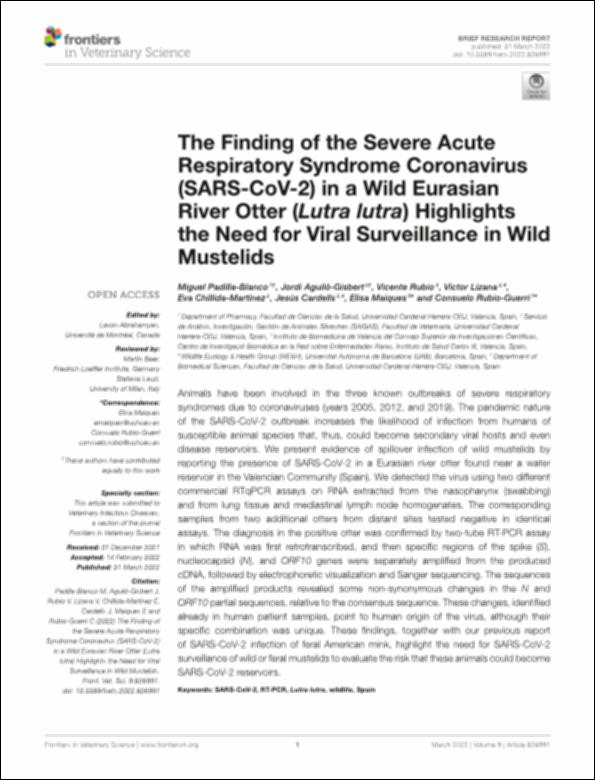Por favor, use este identificador para citar o enlazar este ítem:
http://hdl.handle.net/10637/13614The finding of the severe acute respiratory syndrome coronavirus (SARS-CoV-2) in a wild Eurasian river otter (Lutra lutra) highlights the need for viral surveillance in wild mustelids
| Título : | The finding of the severe acute respiratory syndrome coronavirus (SARS-CoV-2) in a wild Eurasian river otter (Lutra lutra) highlights the need for viral surveillance in wild mustelids |
| Autor : | Padilla Blanco, Miguel Aguiló Gisbert, Jordi Rubio Zamora, Vicente Lizana Martín, Víctor Manuel Chillida Martínez, Eva Cardells Peris, Jesús Maiques Fernández, Elisa Rubio Guerri, Consuelo |
| Materias: | SARS-CoV-2 (Virus); COVID-19.; COVID-19 (Disease); Eurasian otter - Coronavirus infections.; Feral animals - Diseases.; Nutria europea - Infecciones por coronavirus.; Animales salvajes - Enfermedades. |
| Editorial : | Frontiers Media |
| Citación : | Padilla-Blanco, M., Aguiló-Gisbert, J., Rubio, V., Lizana, V., Chillida-Martínez, E., Cardells, J., Maiques, E. & Rubio-Guerri, C. (2022). The finding of the severe acute respiratory syndrome coronavirus (SARS-CoV-2) in a wild Eurasian river otter (Lutra lutra) highlights the need for viral surveillance in wild mustelids. Frontiers in Veterinary Science, vol. 9, art. 826991 (31 mar.). DOI: https://doi.org/10.3389/fvets.2022.826991 |
| Resumen : | Animals have been involved in the three known outbreaks of severe respiratory syndromes due to coronaviruses (years 2005, 2012, and 2019). The pandemic nature of the SARS-CoV-2 outbreak increases the likelihood of infection from humans of susceptible animal species that, thus, could become secondary viral hosts and even disease reservoirs. We present evidence of spillover infection of wild mustelids by reporting the presence of SARS-CoV-2 in a Eurasian river otter found near a water reservoir in the Valencian Community (Spain). We detected the virus using two different commercial RTqPCR assays on RNA extracted from the nasopharynx (swabbing) and from lung tissue and mediastinal lymph node homogenates. The corresponding samples from two additional otters from distant sites tested negative in identical assays. The diagnosis in the positive otter was confirmed by two-tube RT-PCR assay in which RNA was first retrotranscribed, and then specific regions of the spike (S), nucleocapsid (N), and ORF10 genes were separately amplified from the produced cDNA, followed by electrophoretic visualization and Sanger sequencing. The sequences of the amplified products revealed some non-synonymous changes in the N and ORF10 partial sequences, relative to the consensus sequence. These changes, identified already in human patient samples, point to human origin of the virus, although their specific combination was unique. These findings, together with our previous report of SARS-CoV-2 infection of feral American mink, highlight the need for SARS-CoV-2 surveillance of wild or feralmustelids to evaluate the risk that these animals could become SARS-CoV-2 reservoirs. |
| Descripción : | Este artículo se encuentra disponible en la siguiente URL: https://www.frontiersin.org/articles/10.3389/fvets.2022.826991/full |
| URI : | http://hdl.handle.net/10637/13614 |
| Derechos: | http://creativecommons.org/licenses/by/4.0/deed.es |
| ISSN : | 2297-1769 (Electrónico) |
| Fecha de publicación : | 31-mar-2022 |
| Centro : | Universidad Cardenal Herrera-CEU |
| Aparece en las colecciones: | Dpto. Ciencias Biomédicas |
Los ítems de DSpace están protegidos por copyright, con todos los derechos reservados, a menos que se indique lo contrario.


